
The amphisbaena is a mythological, ant-eating serpent with a head at each end. The creature is alternatively called the amphisbaina, amphisbene, amphisboena, amphisbona, amphista, amfivena, amphivena, or anphivena, and is also known as the "Mother of Ants". Its name comes from the Greek words amphis, meaning "both ways", and bainein, meaning "to go".
Arda or ARDA may refer to:

Amphisbaena caeca, commonly known as the Puerto Rican worm lizard or blind worm lizard, is a species of worm lizard endemic to Puerto Rico. These animals are vermicular reptiles that live under logs, rocks, and dirt. Other species of Amphisbaenids in the Caribbean include Amphisbaena bakeri, Amphisbaena fenestrata, Amphisbaena schmidti, Amphisbaena xera, and Cadea blanoides.
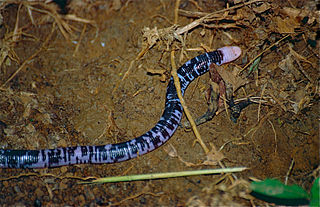
Amphisbaena fuliginosa, also known as the black-and-white worm lizard, speckled worm lizard or spotted worm lizard, is a species of amphisbaenian in the genus Amphisbaena. The ecology of A. fuliginosa is poorly known due to its fossorial habits. However, this species can be easily distinguished from others because of its characteristic white and black mosaic pattern that covers both the dorsal and ventral side.
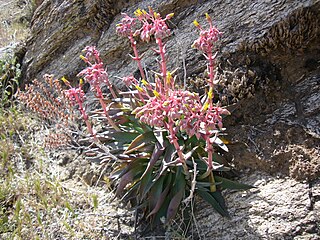
Dudleya saxosa is a perennial succulent plant species in the family Crassulaceae, within the genus Dudleya, which are commonly known as liveforevers. This species is a complex of 3 subspecies of plants, isolated and disjunct in distribution from one another, each with varying levels of ploidy and morphology. One plant is native throughout the deserts and mountains of Southern California, another is found in the Panamint Mountains, and one is found throughout central Arizona.

Claytonia saxosa, known by the common name Brandegee's springbeauty, is a species of wildflower in the family Montiaceae.

Amphisbaena is a genus in the family Amphisbaenidae, commonly known as worm lizards. Over 100 species are placed in this diverse genus.

Amphisbaena alba, also known as the red worm lizard or less commonly as the white or white-bellied worm lizard, is a species of amphisbaenian in the reptilian order Squamata. Despite the large geographic range that this species covers, little is known about its ecology due to its secretive habits. A. alba has a diverse diet ranging from plant material to small vertebrates. Numerically, beetles, ants, and spiders compose the majority of their diet; however, ants, insect larvae, beetles, cockroaches, hemipterans, mole crickets, crickets, grasshoppers, termites, spiders, scorpions, pseudoscorpions, and annelids are ingested to satisfy a larger volume. The females are somewhat larger than the males, and can reach over 80 cm, which is quite large for an amphisbaenian. They are known to bury themselves in leafcutter ant nests and hide in the ants’ garbage dump areas to avoid irritating the ants into attacking, and to bury themselves to avoid predation in general.

Darwin's ringed worm lizard is a species of amphisbaenian in the family Amphisbaenidae, endemic to South America.
Vanzolini's worm lizard is a species of amphisbaenian in the family Amphisbaenidae. The species is native to northern South America.
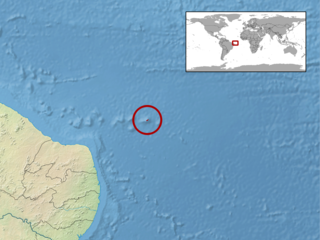
Amphisbaena ridleyi, known by the common names Ridley's worm lizard or the Noronha worm lizard, is a species of amphisbaenian in the family Amphisbaenidae. The species is endemic to the island of Fernando de Noronha off the coast of Brazil. It is one of two indigenous reptiles on the island.
Baker's worm lizard is a species of worm lizard in the family Amphisbaenidae.

Amphisbaena schmidti, known commonly as Schmidt's worm lizard or the Puerto Rican dusky worm lizard, is a species of amphisbaenian in the family Amphisbaenidae. The species is endemic to the Caribbean.
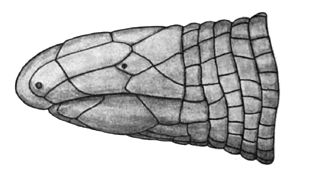
Cadea is a genus of amphisbaenians, commonly known as Cuban keel-headed worm lizards, in the family Cadeidae. Two species are placed in this genus. Both species are endemic to Cuba.
Bossiaea saxosa is a species of flowering plant in the family Fabaceae and is endemic to a restricted area near Norseman, Western Australia. It is an erect, intricately branched shrub with many slightly flattened, sharply-pointed cladodes and deep yellow, red and lemon-yellow, pea-like flowers.

Dudleya saxosa subsp. collomiae, known by the common name Gila County liveforever, is a subspecies of perennial succulent plant within the genus Dudleya native to central Arizona. It is characterized by showy bright-yellow flowers on an upright inflorescence colored pink, red or orange. The leaves are green or covered in a white, powdery wax. This species is found growing in rocky slopes, canyons, and crevices, and often on Sonoran Desert sky islands.

Dudleya saxosasubsp. aloides is a species of perennial succulent plant in the family Crassulaceae known by the common names desert dudleya or desert savior. It is a rosette-forming species widely distributed throughout the Peninsular Ranges and desert mountains of California in the United States. It is characterized by bright-yellow or greenish-yellow flowers, and can be found in shaded crevices and slopes. Plants in western half of the range may grade into Dudleya lanceolata.
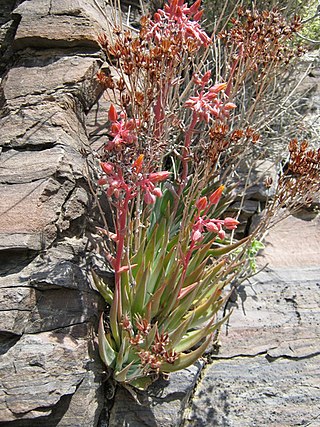
Dudleya saxosasubsp. saxosa is a species of succulent perennial plant endemic only to the western Panamint Range of California. It is known commonly as the Panamint liveforever or Panamint dudleya. It is found on north-facing, granitic or limestone slopes and grows up to 20 cm wide. It is characterized by bright yellow, red tinged flowers, which bloom from May to June.

Myosotis saxosa is a species of flowering plant in the family Boraginaceae, endemic to the North Island of New Zealand. Joseph Dalton Hooker described the species in 1853. Plants of this species of forget-me-not are perennial rosettes with ebracteate inflorescences and white corollas with stamens that are exserted.













